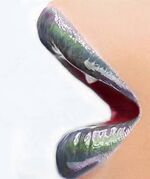Silver
Silver is the colour of silver, a metallic element defined by the fact that it is silver in colour and subsequently often described as silvery.[1] The colour silver is, in fact, only considered silver due to its shininess; without it, silver will fade to some form of grey such as lead or uranium or another dull element.
The eleventh colour on the periodic table, silver is prized for its qualities as both a transitional metal and aesthetic trait. It is the only colour that is a capable semiconductor, and is highly valued in high-end electronics. Unfortunately, its rarity and subsequent priciness prevent it from being used in the private sector; limiting its revolutionary effects on digital rendering to government projects and the playthings of the very wealthy.
Depiction in Media[edit]
Normally very shiny, silver becomes nearly indistinguishable from the non-metal grey when rendered in digital media, due to the fact that typical computers are not made of silver. Instead, computers are usually manufactured with various shades of greys that together form the colours with which regular users are familiar.
When silver is utilised in the manufacture of computer displays, however, the range of colours is not only expanded but the colours themselves are augmented. The ability to render as shiny enables monitors to display what has best been described, in the words of an interviewed drunk, "psychedelic, man... psychedelic."[2] He passed out shortly after and did not respond to further questioning.
Quicksilver Scandals[edit]
Originally believed to be a liquid form of silver, quicksilver was discovered to not be silver at all when scientists, in an attempt to solidify quicksilver into silver and liquefy silver into quicksilver, all mysteriously died. Further investigation revealed quicksilver to be quite poisonous. The fact that quicksilver is also not actually that shiny only added to the doubts.
For the most part, the entire matter died off after this, though several pro-quicksilver groups continued to research the matter. Finally, against all odds, one group of pro-quicksilver advocates conceived an ultimate plan to prove the silveriness of quicksilver, but unfortunately died of mercury poisoning before they could carry it out. After that, most of the others lost hope and to this day, quicksilver is not considered silver.
Even attempts to treat it to become silver have not been made, not after the evidence of its lethality was released.
Discovery of Silver[edit]
Discovered in 1892BC by Abyssinian surveyors attempting to scope a hillside when they were suddenly blinded by light shining off a shiny metallic object, silver was immediately prized for its pure shininess, or it would have been if they had still been able to see after this initial blindedness.[3] Finally, as their untrained eyes slowly adjusted to the glare from the as yet unnamed silver, the astounded and awed surveyors gathered around the gleaming mass and knew that the future lay before them. They had stumbled upon something amazing.
Excitedly, they brought samples of this silver back to their civilisation. The nobles and the wealthy were in awe, but had no trouble at all taking the naïve surveyors by surprise, going on to steal the monumental discovery for themselves.
Nobody paid any mind to the bodies later found in a nearby ditch.
And the rest is history.
Examples[edit]
Things that are silver[edit]
- Silver
- Platinum
This may seem overly tautological, but silver is, in fact, the only thing in existence that is silver. Unlike other colours, there is no categorisation nor any myriad hues or variant values or classes of other colours. Only silver is as shiny as silver.
Besides platinum, that is.
Things that could be silver if properly treated[edit]
Many people, including professional metalworkers as well as random passers-by, have wondered over the years if it would not be possible to manufacture silver out of other similar colours and elements, adding elemental properties to the colours and colour properties to the elements. While much research and experimentation has gone into this, it was not until recently that researchists finally found the key to treating materials into silver: beating the molecular and photonic structures with a crowbar.[4]
So far, these have been successfully treated:
Normally, after all, these elements fall short of silver in one key area: their shininess. The question then remains: what of other elements and colours that already are shiny enough, but merely not the right type of colour? It is speculated that further crowbarring would suffice in this area as well, but the means have yet to be discovered.
Notes[edit]
- ↑ Silver, is, in fact, quite silvery; this is why it is called 'silver'.
- ↑ At least, we think he was talking about silver. He was pretty out of it.
- ↑ It was really shiny. It is postulated that this may, in fact, have been a concentrated deposit. While no others have been found, the surviving depictions and records support the theory of silver concentrate.
- ↑ Technically, 'crowbar' is the wrong word. The proper term is 'prybar,' but media influences and lacking edumacations have mainstreamed the use of the less correct term.
| CHART OF PRIMARY COLOURS – Colours – Colors |
|
Brown
Red
Orange
Gold
Yellow
Olive
Green
Cyan
|
| H | | He | |||||||||||||||
| Li | Be | | B | C | N | O | F | Ne | |||||||||
| Na | Mg | | Al | Si | P | S | Cl | Ar | |||||||||
| K | Ca | Sc | Ti | V | Cr | Mn | Fe | Co | Ni | Cu | Zn | Ga | Ge | As | Se | Br | Kr |
| Rb | Sr | Y | Zr | Nb | Mo | Tc | Ru | Rh | Pd | Ag | Cd | In | Sn | Sb | Te | I | Xe |
| Cs | Ba | Lu | Hf | Ta | W | Re | Os | Ir | Pt | Au | Hg | Tl | Pb | Bi | Po | At | Rn |
| Fr | Ra | Lr | Rf | Db | Sg | Bh | Hs | Mt | Ds | Rg | Cn | Nh | Fl | Mc | Lm | Ts | Og |
| | |||||||||||||||||
| La | Ce | Pr | Nd | Pm | Sm | Eu | Gd | Tb | Dy | Ho | Er | Tm | Yb | ||||
| Ac | Th | Pa | U | Np | Pu | Am | Cm | Bk | Cf | Es | Fm | Md | No | ||||


